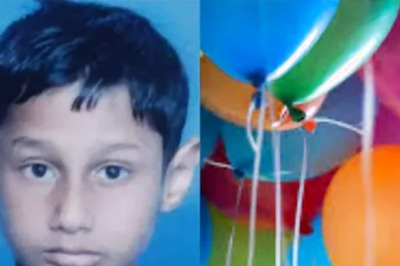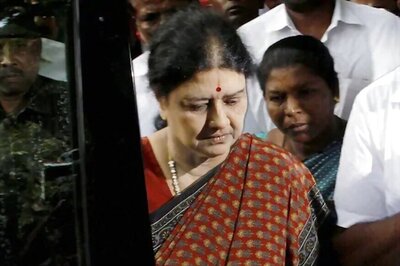
views
In a candid and revealing interview, actor Upen Chauhan opens up about the emotional and psychological challenges he faced while stepping into the notorious shoes of Tikka Khan in the film “Sam Bahadur.” Known for his dedication to his craft, Upen delves into the complexities of the character, his physical transformation for two distinct ages, and the camaraderie shared with co-star Vicky Kaushal. Read on as we explore the behind-the-scenes insights and the actor’s perspective on the film’s impact on portraying the Indian Army’s journey on the cinematic screen.
Can you elaborate on the emotional and psychological challenges you faced while portraying Tikka Khan, considering his notorious role in history?
I found peace with the character during its preparation phase. My approach involved shedding any preconceived judgments as I delved into the research on Tikka Khan. In my acting training, the focus has always been on understanding why a character makes certain choices, exploring the motivations that lead them to believe their actions are the best given their circumstances. As Upen, I must navigate through distinct reasons influenced by nationality, conditioning, and beliefs, which may differ from my own. To authentically portray characters like Tikka Khan, I needed to detach myself from personal judgments and immerse into their mindset.
PS: The primary challenges I encountered were associated with the physical strain endured during boxing training.
How did you approach the moral complexities of Tikka Khan’s character, given his involvement in the tragic events of the Bangladesh Liberation War?
Certainly, justifying the act of ordering a genocide of innocent unarmed people, particularly students, is an inherently challenging task, as it is unequivocally wrong under any circumstance. Rather than approaching it based on factual justifications, I adopted a perspective akin to a child’s play—imagining it as a plot to reclaim one’s toys from bullies who had taken them. While this analogy may sound lighthearted, for a child, such schemes can feel significant, and they might perceive their solitary plans as potentially hazardous.
The physical transformation you underwent to portray two distinct ages is impressive. Could you share more about the specific aspects of your training and diet during the weight gain and loss process?
The shooting schedule dictated that the older version was to be filmed three months before the
younger version. In response, I immediately halted all workouts (except walking) and gradually reintroduced all the foods I loved from my childhood—chole bhature, aloo paratha, pizza, samosa, kalakand, barfi, waffles, chocolates, naans, and more. My focus was on ensuring I walked enough each day to keep my body functioning. This approach proved successful, leading to a loss in muscle size and a gain of 10 kgs of fat in a span of one and a half months. Once the older version’s shoot concluded, I gradually transitioned back to a healthy diet and commenced my workout routine. Subsequently, I had to shoot for another film, Ishq Jhamela, during the interim, which took place in London. Maintaining the diet and workout regimen became challenging in that setting. However, upon returning from London, I recommitted to a strict diet (limited to Indian food with less oil and spices) and resumed weight training. It took approximately one and a half months to shed the excess fat and gain 8 kgs of muscle.
Collaborating with Vicky Kaushal seems to have been a positive experience. Can you share a memorable moment from the set that reflects the camaraderie between you and Vicky?
Certainly, I’ve shared quite a bit about his personality and artistic qualities. If I were to highlight one among countless moments, it would be an incident during the boxing match shoot. It was the last day of that schedule, and the final knockout punch combination wasn’t quite connecting with my face. Despite being cautious to avoid causing any real harm, it was the third consecutive day of intense boxing sessions lasting 12 hours each. Our bodies were exhausted, every part ached, and the day was coming to an end. I suggested, “Let’s just go for it, if it hurts, so be it.” He hesitated, insisting he shouldn’t hurt me. The punch combination required me to walk towards him while he took a long step with each punch from a distance. I made an extra effort to get closer, and I believe he also exerted that extra effort. The punch unexpectedly hit my chin, causing me to fall straight to the ground, shocking everyone. Vicky bhai became genuinely concerned for my well-being. Both he and Meghna asked if I was okay to continue shooting, assuring me it was fine if I needed a break for that day. Knowing it was the last day at that location, I insisted we continue. After a 5-minute break, we completed the sequence that day. When the makeup artist removed the makeup at the end of the day, I called her to mention that the wounds and bruises makeup didn’t come off, to which she
replied, “Because it’s real.” We shared a laugh about it. While it was an accidental occurrence, which is somewhat expected on a set during an action sequence, Vicky bhai felt genuinely remorseful about it and continued to apologize for months. He took care of me, ensured I stayed hydrated, and stood by me throughout the incident. He even offered to handle my skin treatment, but I declined, saying it’s okay, and it’s something I’ll cherish until it heals naturally. He truly is one of the kindest human beings I’ve ever encountered.
Given the intense subject matter of Sam Bahadur, how did the cast and crew maintain a balance between the seriousness of the narrative and creating a positive work environment?
I believe it all stemmed from the seriousness and positivity exuded by Meghna Gulzar. The way she led everything automatically aligned and set everything right.
What kind of research did you undertake to understand Tikka Khan’s character, and how did you navigate the challenge of portraying someone with a controversial historical legacy?
There is ample material about Tikka Khan available on the internet, and Meghna provided me with significant insights about him. Analyzing his real pictures offered valuable cues on how he might have conducted himself in life. I dedicated time to practice his body posture and facial expressions, and surprisingly, this process generated a peculiar sensation in my body—a feeling distinct from my own, providing me with a glimpse of how Tikka Khan might have felt during those moments captured in the pictures. Since I couldn’t find any images or information about his younger days, I relied on the script and the guidance Meghna provided to shape my understanding. The
combination of this data and the emotional essence I experienced became instrumental in creating a pathway for the character.
The film focuses on the journey of Sam Manekshaw and the Indian Army. In what ways does the narrative provide insight into the parallel stories of these two entities?
The narrative of this story revolves around Field Marshal Sam Manekshaw, focusing specifically on his journey. It delves into only those of Tikka’s actions or interactions with Sam Manekshaw that significantly impacted Sam’s life or contributed to the decisions shaping his life. While it’s evident that Sam and Tikka shared a timeline at the Indian Military Academy (IMA) and both pursued boxing, their paths diverged after the partition. Sam stayed in India, whereas Tikka went to Pakistan. During the period of Marshal Law in Pakistan, Sam served as the Chief of Army Staff of India, while Tikka Khan held the position of Chief of Army Staff in Pakistan. They found themselves on opposing sides during different phases of their lives. What adds an intriguing dimension to their relationship is that, despite finding themselves on opposing sides numerous times, there was consistently minimal or no communication between Sam Manekshaw and Tikka Khan.
Your comments on Vicky Kaushal’s dedication and talent are commendable. Can you share an instance that showcases his commitment to his craft during the filming of Sam Bahadur?
His dedication is evident in his consistent presence on set. Always punctual, he commits 100% to every task. What sets him apart is his approach—he prepares and absorbs instructions like a diligent student, yet when it comes to performance, he seamlessly transforms into a seasoned professional.The transition from casual interactions on set to embodying the character of Sam Manekshaw is so smooth that it happens in the blink of an eye. It’s as if he’s not acting but merely behaving authentically. The fluidity of this transition underscores the extensive preparation he must have undertaken to achieve such a high level of ease.
The decision to avoid prosthetics for Tikka Khan’s look is intriguing. What motivated this choice, and how did it impact your portrayal of the character?
The decision wasn’t deliberate; it happened organically. In the preparation phase, I recognized the importance of feeling the age of the character. The idea of gaining weight naturally and organically struck me, driven by my own curiosity. It wasn’t a directive to undergo an extensive transformation; I did it out of my own interest. I see it as one of the many ways to align your psyche with the character’s—a bit like a child donning a lively mask, forgetting themselves, and adopting the persona of the masked character. What’s intriguing is that this mask becomes an integral part of this new being, aiding in the portrayal. The process of physical transformation serves as a constant tether to my intention of embodying the character. Throughout the transformation phase, I am acutely aware of the purpose—becoming that character. This continuous awareness, sustained over an extended period, fosters a deeper and more profound connection with the character. I believe prosthetics can sometimes limit the freedom of an actor’s expression. While there are cases where it’s necessary, in situations where I can sidestep it and enhance my performance, I prefer to do so.
As an actor, how do you think Sam Bahadur contributes to the portrayal of the Indian Army’s journey on the cinematic screen, and what message do you hope the audience takes away from the film?
When I think about the journey of Sam Manekshaw, it’s not just his story—it’s the heartbeat of the Indian Army echoing through time. Sure, there are different angles to tell the tale of our army— politicians, civilians—but for me, it feels most genuine when it’s seen through the eyes of a soldier. Imagine having someone who’s been there since the British handed over the reins, someone who’s worn almost every hat in the department, fought in World War II, and stood firm in every conflict we’ve faced. That’s not just a point of view; that’s a living, breathing testament to our history. Even though the film centers around Sam Manekshaw, you can’t unravel his narrative from the very fabric of the Indian Army. His life is an inseparable part of the institution. Watching this film is like taking a journey that’s both subtle and profound, learning about Sam and the army in the most honest way possible. It’s not just a movie; it’s a patriotic lesson that stirs your soul. When you walk out of the theater, you carry more than just the story of a man; you carry a sense of patriotism, a belief that discipline is the backbone that gives us the courage to lead, decide, win, and take responsibility. It’s a piece of our history that leaves you not just entertained but deeply connected to the values that make Sam Manekshaw and the Indian Army extraordinary.




















Comments
0 comment